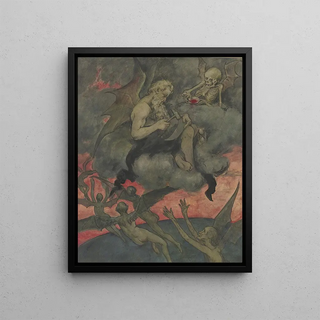Art print | Chronos sharpens the sickle - Hans Thoma


View from behind

Frame (optional)
In the fascinating universe of art, some works do more than capture a moment; they challenge our perception of time and existence. "Art print Chronos aiguise la faux - Hans Thoma" is one of those iconic pieces that, through its rich symbolism and evocative composition, immerses us in a profound reflection on the ephemeral nature of life. This painting, depicting the god of Time, Chronos, preparing his harvesting tool, reminds us of the fragility of our passage on earth and the necessity of seizing every moment. The piece, both powerful and gentle, invites us to contemplate the duality of life and death, while offering an unforgettable aesthetic experience.
Style and uniqueness of the work
Hans Thoma's style is distinguished by its unique approach that blends realism and symbolism. In "Art print Chronos aiguise la faux," vibrant colors and meticulous details create an atmosphere that is both serene and unsettling. The artist uses warm tones to represent Chronos, emphasizing his character as both protector and threat. The flowing lines and soft shapes of the composition contrast with the hardness of the scythe, a symbol of mortality. Thoma manages to establish a dialogue between the beauty of life and the inevitability of death, inviting the viewer to an introspection on their own relationship with time. Every element of the work is carefully thought out, from the expressions of the characters to the details of the landscape, creating a rich tableau full of meanings and emotions.
The artist and his influence
Hans Thoma, born in 1839 in Germany, is an essential figure of the 19th-century artistic movement. His career, marked by an incessant quest for harmony between man and nature, makes him a pioneer in exploring spiritual and mythological themes. Thoma draws inspiration from legends and popular stories, seeking to convey profound messages through his works. His influence is felt not only in the art world but also in popular culture, where his representations of myths and symbols continue to inspire generations of artists. "Art print Chronos aigu"

Matte finish

View from behind

Frame (optional)
In the fascinating universe of art, some works do more than capture a moment; they challenge our perception of time and existence. "Art print Chronos aiguise la faux - Hans Thoma" is one of those iconic pieces that, through its rich symbolism and evocative composition, immerses us in a profound reflection on the ephemeral nature of life. This painting, depicting the god of Time, Chronos, preparing his harvesting tool, reminds us of the fragility of our passage on earth and the necessity of seizing every moment. The piece, both powerful and gentle, invites us to contemplate the duality of life and death, while offering an unforgettable aesthetic experience.
Style and uniqueness of the work
Hans Thoma's style is distinguished by its unique approach that blends realism and symbolism. In "Art print Chronos aiguise la faux," vibrant colors and meticulous details create an atmosphere that is both serene and unsettling. The artist uses warm tones to represent Chronos, emphasizing his character as both protector and threat. The flowing lines and soft shapes of the composition contrast with the hardness of the scythe, a symbol of mortality. Thoma manages to establish a dialogue between the beauty of life and the inevitability of death, inviting the viewer to an introspection on their own relationship with time. Every element of the work is carefully thought out, from the expressions of the characters to the details of the landscape, creating a rich tableau full of meanings and emotions.
The artist and his influence
Hans Thoma, born in 1839 in Germany, is an essential figure of the 19th-century artistic movement. His career, marked by an incessant quest for harmony between man and nature, makes him a pioneer in exploring spiritual and mythological themes. Thoma draws inspiration from legends and popular stories, seeking to convey profound messages through his works. His influence is felt not only in the art world but also in popular culture, where his representations of myths and symbols continue to inspire generations of artists. "Art print Chronos aigu"






